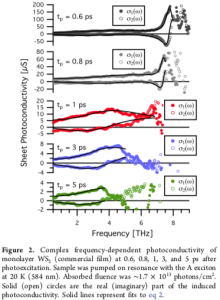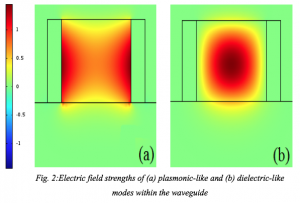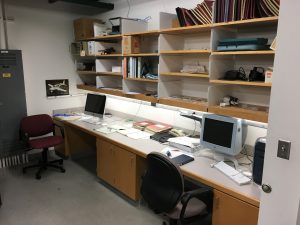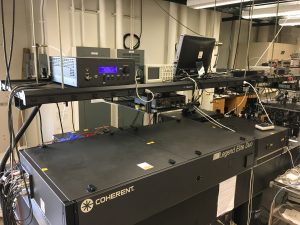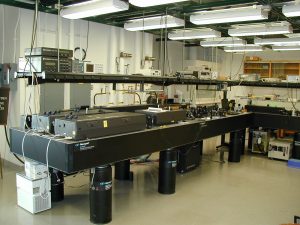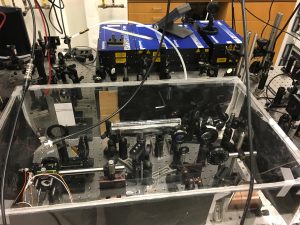Current Projects
We are interested in the nature of photo-induced charge generation in 2-D TMDCs and the subsequent evolution of the electron-hole pairs after their creation. in particular, we are interested in using time-resolved terahertz spectroscopy (TRTS) to measure the frequency dependent nature of the conductivity and the mobility of the charge carriers. We also intend to modify these behaviors via chemical and optical doping in an effort to further control the conductive properties of these materials.
- Enhancing poling efficiency in electro-optic polymers
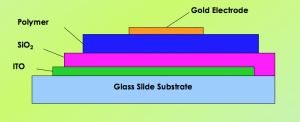 Electro-optic (EO) polymers are created by adding a small chromophore (dye molecule) to a polymer matrix either by covalently bonding the chromophore to the polymer chain or by physically mixing the two components. Nonzero EO coefficients are imparted to the composite by the application of large static electric fields at temperatures near or slightly above the glass transition temperature of the composite, a process known as poling. The fields are typically near the breakdown field associated with the composite. To enhance the poling efficiency, yet reduce the likelihood of dielectric breakdown of the composite during poling, various techniques ranging from the addition of highly resistant thin films to the addition of highly ionic substrates are being studied.
Electro-optic (EO) polymers are created by adding a small chromophore (dye molecule) to a polymer matrix either by covalently bonding the chromophore to the polymer chain or by physically mixing the two components. Nonzero EO coefficients are imparted to the composite by the application of large static electric fields at temperatures near or slightly above the glass transition temperature of the composite, a process known as poling. The fields are typically near the breakdown field associated with the composite. To enhance the poling efficiency, yet reduce the likelihood of dielectric breakdown of the composite during poling, various techniques ranging from the addition of highly resistant thin films to the addition of highly ionic substrates are being studied.
- THz difference frequency generation in organic electro-optic polymer waveguides
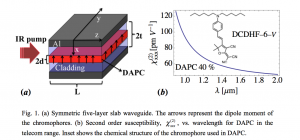 A widely used method to produce ultra-broadband terahertz (THz) pulses is to mix the frequency components of infrared (IR) femtosecond (fs) pulses through difference frequency generation (DFG) in organic and inorganic crystals. Pulsed fiber laser systems operating at telecom wavelengths are compact and have the potential to provide portable ultra- broadband THz sources outside the laboratory. However, these systems are power limited and only a few materials are well phase-matched at these wavelengths for generation in a broadband THz range (DAST and electro-optic (EO) polymers). Poled EO guest-host polymer films are attractive since their material properties are tunable and provide an inexpensive alternative to crystal based ultra-broadband THz emitters. In addition, guided wave geometries can overcome some of the difficulties involved in using these materials in their bulk form.
A widely used method to produce ultra-broadband terahertz (THz) pulses is to mix the frequency components of infrared (IR) femtosecond (fs) pulses through difference frequency generation (DFG) in organic and inorganic crystals. Pulsed fiber laser systems operating at telecom wavelengths are compact and have the potential to provide portable ultra- broadband THz sources outside the laboratory. However, these systems are power limited and only a few materials are well phase-matched at these wavelengths for generation in a broadband THz range (DAST and electro-optic (EO) polymers). Poled EO guest-host polymer films are attractive since their material properties are tunable and provide an inexpensive alternative to crystal based ultra-broadband THz emitters. In addition, guided wave geometries can overcome some of the difficulties involved in using these materials in their bulk form.
We are interested in developing ultra-broadband THz DFG guided wave devices. A symmetric, five-layer, slab waveguide has the ideal geometry for exploiting the EO polymer nonlinearity, achieving good phase-matching conditions and managing THz attenuation. The two metal capping layers help confine the modes involved in the interaction. The IR pump is coupled to the fundamental TM mode that is bounded inside the EO core and entirely polarized parallel to the poling direction. The THz radiation is collected by the fundamental TEM-like mode that extends spatially in the entire core/cladding section of the waveguide. The low loss cladding layers help mitigate both the high THz losses introduced by the lossy core and metal capping layers.
We are also using finite element analysis to predict the mode structure and efficiency of THz generation in DFG waveguides.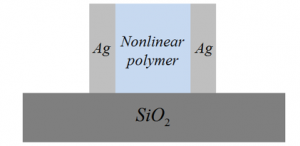
Facilities and equipment
25-fs amplified Ti:Sapphire laser system (Coherent Legend Elite Duo-USX, w/ OPerA Solo OPA)
THz lab
THz experimental setup
